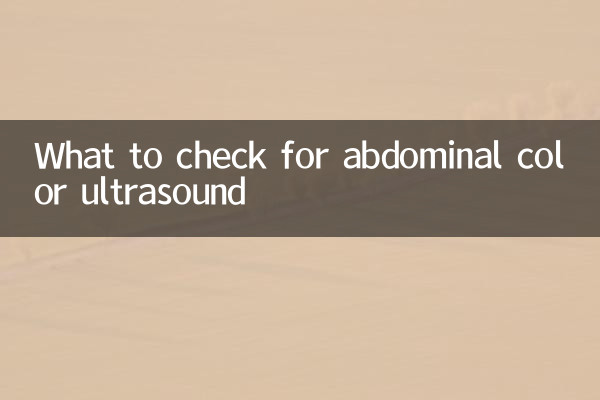What should I check for abdominal color ultrasound? Comprehensive analysis of examination items and clinical significance
Abdominal color ultrasound (color Doppler ultrasound) is a non-invasive, safe and efficient imaging examination method, which is widely used in clinical diagnosis. It can clearly display the shape, blood flow signals and lesions of the abdominal organs. The following is a detailed analysis of the abdominal color ultrasound examination project, one of the hot topics in the medical and health field in the past 10 days, and is presented to you with structured data.
1. Core examination items for abdominal color ultrasound

| Inspection location | Main observation content | Common abnormal prompts |
|---|---|---|
| liver | Size, morphology, echo, blood vessel distribution | Fatty liver, cysts, tumors, cirrhosis |
| gallbladder | Wall thickness, bile sound permeability, stones | Cholecystitis, gallstones, polyps |
| pancreas | Contour, parenchymal echo, pancreatic duct dilation | Pancreatitis, pseudocysts, tumors |
| spleen | Size, internal echo, blood flow signal | Splenic enlargement, infarction, placeholding lesions |
| kidney | Cortical thickness, collection system, stones | Kidney stones, hydrocalories, cysts, tumors |
| Abdomen blood vessels | Abdominal aorta and portal vein hemodynamics | Aneurysms, thrombosis, portal hypertension |
2. Recent hot topics
1.Fatty liver screening demand surges: According to data from the health platform, the search volume of "fatty liver self-examination" in the past 10 days has increased by 35% month-on-month, and abdominal color ultrasound, as the first choice diagnostic tool, has attracted attention.
2.Gallstone prevention science: The number of readings on the topic of "asymptomatic gallstones" on social media exceeded 100 million, and the value of early detection of ultrasound examinations has been emphasized many times.
3.Joint detection of tumor markers: Discussions in the medical forum show that the combined application of abdominal color ultrasound and tumor markers such as AFP and CA19-9 has become a new trend in early cancer screening.
3. Preparations before inspection
| Prepare the project | Specific requirements | Scientific basis |
|---|---|---|
| Fasting Requirements | Fasting for 8-12 hours | Reduce gas interference in the gastrointestinal tract |
| Drinking water requirements | Drinking water 500ml 1 hour before inspection | Fill the stomach to create sound window |
| Clothing requirements | Loose clothing | Easy to expose the inspection area |
| Special group of people | Diabetic patients need to prepare sugar cubes | Prevent hypoglycemia |
4. Clinical FAQs
1.Why do we need to review sometimes?: When suspected placeholding, tiny stones or critical values of measurement data are found, the doctor may recommend a review within 1-3 months to confirm the diagnosis.
2.How to choose color ultrasound and CT?: Color ultrasound is suitable for screening and dynamic observation, and CT has more advantages in complex anatomical structure display and tumor staging, and the two are complementary rather than substitute.
3.Can pregnant women undergo abdominal color ultrasound?: Ultrasound examination has no radiation and can be performed safely during pregnancy, but uterine enlargement in the late pregnancy may affect the development of some organs.
5. New technological progress
1.Ultrasonic elastologic imaging technology: The degree of liver fibrosis can be quantitatively evaluated, and the popularity rate in Grade A hospitals has increased significantly recently.
2.Artificial intelligence-assisted diagnosis: The AI algorithm can automatically identify typical lesions such as stones and cysts, and the examination efficiency is improved by about 40%.
3.Three-dimensional volume imaging: The new probe can realize the three-dimensional reconstruction of the organ and show unique advantages in tumor positioning.
According to the latest medical data, standardized abdominal color ultrasound examination can increase the early diagnosis rate of digestive diseases by more than 60%. It is recommended that people over 40 years old undergo routine screening once a year, and high-risk groups (such as hepatitis B carriers and long-term drinkers) should shorten the examination interval. After the examination, be sure to interpret the report by a professional physician to avoid over-interpreting ultrasound description terms by yourself.

check the details

check the details